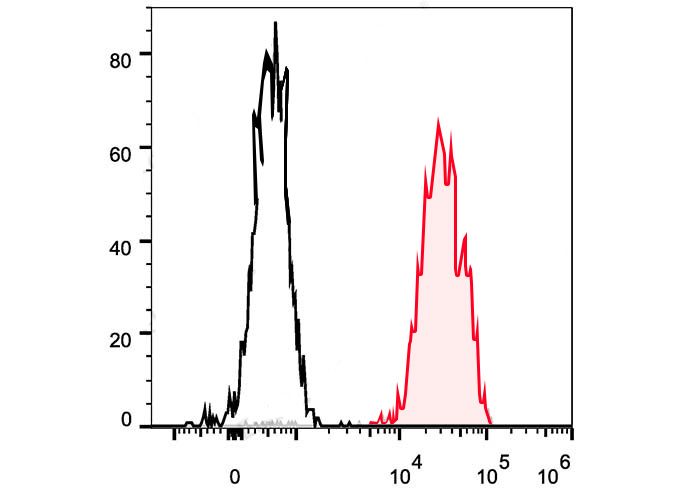Products
FITC Anti-Human CD48 Antibody(156-4H9)
- SPECIFICATIONS
- FIGURES
- CONDITIONS
- FAQS
- Product Name
- FITC Anti-Human CD48 Antibody(156-4H9)
- Catalogue No.
- FITC-30195
- Form
- liquid
- Conjugation
- FITC
- Conjugation Information
- FITC is designed to be excited by the Blue laser (488 nm) and detected using an optical filter centered near 530 nm (e.g., a 525/40 nm bandpass filter).
- Clonality
- Monoclonal
- Isotype
- IgG1, κ
- Clone ID
- 156-4H9
- Storage
- PBS with 0. 1% sodium azide, 1%BSA, pH 7.3, 2-8℃ for 12 months (Avoid repeated freeze / thaw cycles.)
- Alternative Names
- BCM1 surface antigen|BLAST-1|CD48|CD48 antigen|Cd48|HM48-1|MRC OX-45 surface antigen|SLAMF2|sgp-60 antibody
- UniProt ID
- P09326
- Tested Applications
- FC
- Recommended dilution
- Volume per test: 5μL. Each lot of this antibody is quality control tested by flow cytometric analysis. The amount of the reagent is suggested to be used 5 µL of antibody per test (million cells in 100 µL staining volume or per 100 µL of whole blood). Please check your vial before the experiment. Since applications vary, the appropriate dilutions must be determined for individual use.
 Human peripheral blood lymphocytes are stained with FITC Anti-Human CD48 Antibody (filled gray histogram). Unstained lymphocytes (black histogram) are used as control.
Human peripheral blood lymphocytes are stained with FITC Anti-Human CD48 Antibody (filled gray histogram). Unstained lymphocytes (black histogram) are used as control.
- Background
- CD48 is a 40-47 kD GPI-anchored membrane protein, also known as Blast-1 and HuLy-m3. It is a member of the CD2 family that contains 2 IgSF domains and is widely expressed on both resting and activated hematopoietic cells with the exception of granulocytes, platelets, and erythrocytes. CD48 binds to CD2 at a considerably (>100-fold) lower affinity than CD58. It is thought to contribute to T cell activation. The cytoplasmic tail of CD48 has been shown to bind to the kinases Lck and Fyn.
How many times can antibodies be recycled?
First, usually it's not suggested to recycle antibodies. After use, buffer system of antibodies has changed. The storage condition of recycled antibodies for different customers also varies. Thus, the performance efficiency of recycled antibodies can’t be guaranteed. Besides, FineTest ever conducted the antibody recycling assay. Assay results show recycling times of different antibodies also varies. Usually, higher antibody titer allows more repeated use. Customers can determine based on experimental requirements.
Notes: After incubation, we recycle rest antibodies to centrifuge tube and store at 4℃. High titer antibodies can be stored for a minimum of one week. Reuse about three times.
What are components of FineTest antibody buffer?
Components of FineTest antibody buffer are usually PBS with proclin300 or sodium azide, BSA, 50% glycerol. Common preservative is proclin300 or sodium azide, which is widely applied in the lab and industry.
How about the storage temperature and duration of FineTest antibodies?
Most antibodies are stored at -20℃. Directly-labeled flow cytometry antibodies should be stored at 2 - 8℃. The shelf life is one year. If after sales issues for purchased antibodies appear, return or replacement is available. Usually, antibodies can be still used after the one-year warranty. We can offer technical support services.
Is dilution required for FineTest antibodies? What’s the dilute solution?
Directly-labeled flow cytometry antibodies are ready-to-use without dilution. Other antibodies are usually concentrated. Follow the dilution ratio suggested in the manual. Dilute solution for different experiments also varies. Common antibody dilution buffers are acceptable(e.g. PBST, TBST, antibody blocking buffer).
How to retrieve antibodies for immunohistochemistry?
Common retrieval buffers: Tris-EDTA Buffer(pH 9.0); Citrate Buffer(pH 6.0)
Heat induced antibody retrieval:
Method 1: Water-bath heating: Put the beaker with retrieval buffer and slide in the boiling water bath. Keep the boiling state for 15min. Naturally cool to room temperature;
Method 2: Microwave retrieval: Put the beaker with retrieval buffer and slide in the microwave oven. Heat at high power for 5min, Switch OFF for 3min, Heat at medium power for 5min. Naturally cool to room temperature.
How to choose secondary antibodies?
(1) Secondary antibodies react with primary antibodies. Thus, secondary antibodies should be against host species of primary antibodies. E.g. If the primary antibody is derived from rabbit, the relevant secondary antibody should be against rabbit. E.g. goat anti rabbit or donkey anti rabbit.
(2) Choose secondary antibody conjugates according to the experimental type, e.g. ELISA, WB, IHC etc. Common enzyme conjugated secondary antibodies are labelled by HRP, AP etc. Fluorescin or dye labelled secondary antibodies are applied in immunofluorescence and flow cytometry(e.g. FITC, Cy3).
